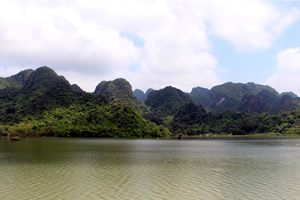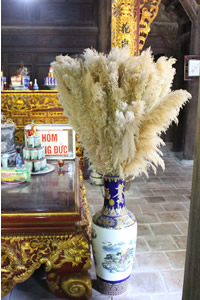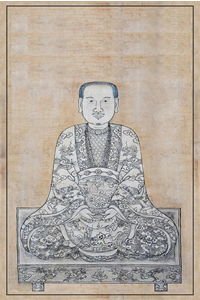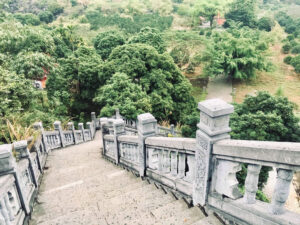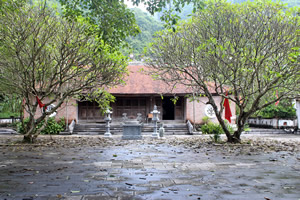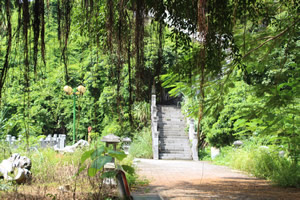Hoa Lư Cave is also referred to as Thung Lau (Lau Valley) as it is not a cave in the normal sense of the word but rather a valley encased on all four sides by mountains. Like the similarly enclosed Am Tien, for centuries the only access was via a hidden and treacherous mountain pass. It was here in this protected natural fortress, that the future King Dinh Bo Linh was raised.
Those familiar with Vietnamese history will recall that this unassuming child would later unite the 12 warlords, overthrow 1000 years of southern Chinese domination and found Dai Co Viet. Also known as King Dinh Tien Hoang, he inaugurated the Dinh Dynasty, the first in a long chain of Vietnamese Dynasties that lasted up until World War 2. So for many, Thung Lau Valley is the birthplace of the modern Vietnam nation in a very literal sense.
The Valley of the Reeds
In recent years, the demand to visit and worship at the lonely Pagoda has increased, leading the local government to expand the parking area and construct a 240-step stone stairway. The stairway winds in several sections, designed to resemble the body of a dragon and has replaced the original steep rocky track. The 3-kilometer-long, 500-meter-wide Cut Lake (Đầm Cút) surrounds the valley and acts as a natural moat around the hills, providing the valley with additional isolation and protection.
Some 16 hectares in total, the “cave” is famous for the reeds that young Dinh Bo Linh played mock war games with. In one interpretation, Hoa Lư supposedly means “reed flower” so Hoa Lư/Thung Lau is aptly named.
In this remote valley of limestone mountains, the wind blows through the reed flowers that intertwine into a silk line like fine white hair, creating a uniquely charming and photographic landscape. From the “dragon stairway”, the sacred temple peeks out from under the old trees while behind you the expansive “moat” below is framed by rugged limestone karsts and tilled fields where buffalo still come to play.
A Legendary Saint
Pride of place here is the temple of Nguyễn Minh Không (1065-1141), a monk who revived Buddhist during the Ly Dynasty, as opposed to the centuries of Confucianism imported by the northern invaders. Vietnamese acknowledge Nguyễn Minh Không as a Zen master and credit him as the father of bronze casting in Vietnam. Often called “Saint Nguyen,” he also demonstrated legendary skills in Vietnamese traditional medicine and earned the title Lý Quốc Sư (National Teacher) from the Lý Kings.
Born in nearby Điền Xá village to poor parents, Saint Nguyễn spent much of his career based in Thung Lau and this has given the place a huge reputation for herbal medicine and “magical” cures. Indeed, his accomplishments and skills have left an indelible mark on Vietnamese history and legend and one can only surmise that his knowledge and acumen were a crucial part of Vietnam’s rise and defeat of the northern invaders.
According to a present day guard, the road to the temple used to be very difficult and only a few people were willing to climb up and down the treacherous mountain trail to the small temple that worshiped both Saint Nguyen Minh Khong. It wasn’t until historians came here to survey that they realized this was where King Đinh began his career and spread the word. Nowadays, it is debatable about who is more revered in Vietnamese ancestry – King Dinh Tien Hoang or Ly Quoc Su – so it is entirely fitting that both have back to back pagodas in this isolated and most revered valley.
Note
Generally speaking, people name places of worship “Pagodas” when they follow the Buddhist religion, while they usually call those of Confucian or Taoist origin “Temples.”This can be confusing in Vietnam as often a Pagoda will also contain Confucian type altars or statues of the famed Mother Goddess of the ancient Đạo Mẫu folk religion and vice versa. However, people do not use the terms interchangeably, and they do not refer to the building style (since temples and pagodas often share similar construction). Instead, the terms refer to the activities that take place inside the buildings.
A Secret Location
Some might find it odd that they buried the birthplace of one of Vietnam’s most famous sons in obscurity for centuries. However, military leaders closely guarded the location of Hoa Lư Cave as they used it as a hidden strategic headquarters during the many incursions and wars throughout Vietnam’s history. Only in recent years have officials opened it up to visitors.
Builders located a second temple in the middle of the valley, behind the Nguyễn Minh Không temple, to honor King Đinh Tiên Hoàng and the generals loyal to him. The pair of temples showcase traditional “Cổng/Quốc” style, while artisans sculpted the altar with dragons, phoenixes, flowers, and foliage. The two kneeling horses on either side represent the war horses King Đinh used effectively during his campaigns against the Song. Caretakers continually fill two large porcelain vases with reed (cane) flowers, which have become the valley’s signature.
A Legendary King
Do not not confuse this temple with the massive Đinh/Lê temple in Hoa Lư proper! Builders constructed this temple on the foundation of the original Thung Lau palace, and over its long and illustrious history, caretakers have renovated, repaired, and expanded it several times. These days, Vietnamese pilgrims often visit to remember and reflect on their long and ultimately successful journey to independence.
According to legend, when King Dinh Tien Hoang was young he frequently went to herd buffalo to help his uncle. On one occasion he slaughtered a buffalo to share with his friends after winning a mock battle using the famous reeds as swords and lances. His uncle immediately realized the herd was one buffalo short and demanded an answer from the young king-to-be.
With some forethought, the young lad had placed the buffalo’s tail in a crack in the ground and claimed that the buffalo was afraid and hid underground. Although the Uncle did not believe the story and chastised the youth, the legend is a much loved story throughout Vietnam and locals have erected a well and commissioned a statue of a buffalo hiding in honor of the king’s boldness even as a youngster.
Travel Tips
The trip is relatively taxing but takes you through some very special and beautiful parts of the rural Ninh Binh. It is suggested to take your time and make it a full morning journey. The staircase into the valley is still quite steep and is best enjoyed before the midday sun arrives. Once there, the air in the valley is crisp and clear and great for a relaxing walk.
If time is available, head back to Van Long for a late lunch and some local color then catch the afternoon migration of the vibrant bird life at Van Long Lake before heading back to your hotel. If you are feeling adventurous, there is also accommodation in the Van Long area which will make for a truly unique visit.
Locals hold an annual festival at the end of the reed flowering season to celebrate the birthday, life, and works of Đinh Bộ Lĩnh.For those interested, it falls on the 8th day of the tenth lunar month (around September-October)
While a reasonable distance from Ninh Binh City, it is fairly easy to find and makes a very scenic journey. First make your way to the marina of the Van Long nature reserve then turn left and continue straight on the long Van Lang dike concourse until you see the large sign for Thung Lau on the right. Of course, with Google maps directions are somewhat redundant but if you lose internet, these directions might help.
On festival days, you might be able to join a tour group however for most part, you will need to self-drive or charter a taxi/Grab ride. Make sure you stipulate the return journey as taxis and their ilk are a rare occurrence in these parts of the woods.

